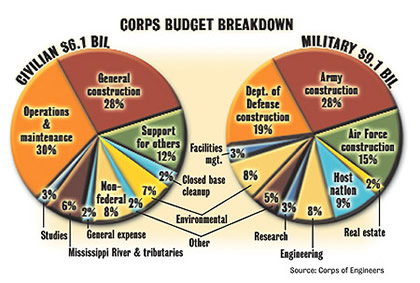Almost wherever it looks–from Afghanistan's rugged terrain to the Mississippi's rolling waters–the Army Corps of Engineers is under fire. In Central Asia, Corps personnel with high-tech tools are on the ground, supporting the military campaign against Al Queda. The Sept. 11 attacks also thrust the Corps deeper into homeland security, with a role in the World Trade Center cleanup and steps to tighten protection at Corps locks and dams.
 |
| TWO FRONTS The Corps is supporting the war on terror in Afghanistan while shifting from its traditional large navigation and flood control work on U.S. waterways. (Photo by William G. Krizan for ENR) |
On another domestic front, the Corps is fighting a war of words, numbers and perceptions. For more than two years, the agency has faced ferocious criticism from environmental and other groups who charge it advances projects that are short on environmental protection or based on bad economics.
Construction firms are watching events closely because the Corps is a major source of work. This year, its program totals $15.2 billion, up 3% from 2001. Of that, 60% is military construction, such as barracks, hospitals and runways for the Army and Air Force.
The other 40% is civil works, a field that has changed, says Lt. Gen. Robert B. Flowers, Chief of Engineers. Fifty years ago, "we were very heavily involved in doing very large construction projects on almost every waterway in the country," he says. "Today we're still working on every waterway in the country, but the types of projects we're doing are different." Flowers notes that there is just one new Corps dam under construction. Much of the civil works budget goes to maintain aging locks, dredging to accommodate bigger ships and restoring the environment.
 |
| 9-11 Corps provided support in New York. (Photo courtesy of The Army Corps of Engineers) |
The biggest environmental project is the $7.8-billion restoration of Florida's Everglades. The Corps has launched a huge "replumbing" job, undoing channelization and other projects it built decades ago that helped lead to the ecosystem's deterioration.
"The mission set has changed," Flowers says. "But the role is to provide quality engineering and science to the nation through our civil works mission and to the armed forces through our military construction mission."
In civil works, outsiders are pushing the Corps hard to do things differently. A prime focus is how it evaluates projects. The latest flareup began April 30, when Maj. Gen. Robert H. Griffin, Corps civil works director, ordered a "pause" for projects that had pre-1999 analyses or changes in economic, engineering or environmental data. That followed Corps halts on big Columbia and Delaware River dredging jobs, after reports of flawed economic studies. On May 17, the Corps said only eight of the 172 projects affected would get a second study as a result of the order. Griffin said the pause showed that many other of the 172 already were in review.
But critics, who were cautiously positive about Griffin's original announcement, exploded. Rebecca R. Wodder, president of American Rivers, slammed the outcome as a "ridiculous charade." Jeff Stein, a Taxpayers for Common Sense policy analyst, said, "They had the chance to restore some of the agency's credibility on how they conduct business, but they blew it."
The controversy is not over. On tap are a series of actions that will signal where Corps policy is headed:
- By May 31, the agency will issue a rewrite of its 40-year-old "Master Manual" for Missouri River flow.
- In July, the Corps will release a revised draft for possible improvements on the upper Mississippi and Illinois Rivers.
- In July, the National Academy of Sciences will issue the first of four reports on how the Corps reviews projects.
- In coming months, the Corps also will decide the fate of the Columbia and Delaware River dredging jobs it put on hold.
- In West Virginia, federal Judge Charles H. Haden II ruled May 8 that the Corps must stop issuing permits giving coal mine operators the right to blast mountaintops and bulldoze the rubble into streams. The decision came just five days after the Environmental Protection Agency redefined mine waste as fill material. Haden said the change would circumvent the Clean Water Act.
"It seems that a lot of different shoes are falling," says Harry N. Cook, president of the National Waterways Conference. "It's very unusual times."
Critics' allies in Congress have introduced bills to require independent reviews of big projects and other steps. Some provisions could wind up in the next Water Resources Development Act, now in early stages on Capitol Hill.


"A lot of the criticism is very dated," Flowers says. In the 1950s, the Corps' preferred flood-control method was "a concrete-lined ditch," he notes. Now, plans will have more local input and may include features that copy nature.
Some complain that Corps planning is biased toward building. Flowers counters that Corps planning today "is a very open public process and attempts to take all factors into consideration." Only about 17% of Corps studies lead to construction, he says. "I think that's a pretty fair winnowing process." He adds, "The process continues to change, evolve, get better."
In March, Flowers unveiled seven "environmental operating principles." First is to strive for environmental sustainability."I firmly believe the engineering and science is good enough today that we can do...development that's good for the economy and a plus for the environment," he says.
Still, all the flak is likely to spur further moves. A former Corps official says: "I think that Flowers is an astute enough reader of the political landscape to know that probably out all of this hoopla some sort of common [project] review is going to come." He says that will be "the minimal pound of flesh...that has to come out of the perceived or the real inadequacies in the process." Cook says Corps officials are "anxious to get their house in order so Congress has continued confidence in the way they're doing business."
But radical shifts aren't likely. The Corps has many friends in Congress who will ensure the next WRDA and appropriations bills will not lack new projects. "I think they're going to do quite well," says Mark Sickles, executive director of the Dredging Contractors of America. "Not as well as they would have to do to reduce the backlog substantially, but I think that the important projects are going to move forward."
For 2003, President Bush proposed trimming Corps civil works 7% to $4.3 billion and cutting the construction account 16% to $1.4 billion. But the budget ritual was shaken up when Mike Parker, assistant Army secretary for civil works, quit suddenly on March 6, apparently under pressure, after he didn't offer a strong enough budget defense before Congress. Observers think lawmakers, who knew Parker as a five-term House member from Mississippi, will give the agency more than Bush sought.
The next major Corps decision is the Missouri manual. "We will have a series of recommendations [for] the most efficient and environmentally sustainable operation of the river," Flowers says. Upstream interests want more water retained there for recreation. Downstreamers want more water released for barge commerce. The Missouri manual will be "a true test of whether the Corps is still captured by its traditional boosters or...ready to comply with modern environmental law," says Scott Faber, Environmental Defense water resources specialist. Whatever the agency does, lawsuits are expected.
On May 10, the agency issued a draft blueprint for the upper Mississippi research. It doesn't recommend specific solutions, but sets the stage for a detailed feasibility study. It calls for reducing congestion at locks and achieving "an environmentally sustainable system." A final draft is due in July, and the report in 2004.
 |
| REPLUMBING Massive Everglades project will undo many old Corps channelization jobs. (Photo courtesy of ACOE) |
Meanwhile, the Corps is battling terrorism, overseas and at home. Flowers says the Corps has $5 million to $10 million in Afghanistan and other central Asian countries to build "semi-permanent" facilities and provide water and power for U.S. troops. Some of its personnel on site are relying on Corps-developed satellite communication kits and "tele-engineering" to link them to U.S. engineering centers. As of mid-April, the Corps had about 100 people in central Asia, says Flowers."There is a potential for more," he adds.
Rebuilding Afghanistan will take $15 billion over 10 years, according to the United Nations, World Bank and Asian Development Bank. On April 17, Bush endorsed a recovery program for the country, citing the post-World War II Marshall Plan. The Corps hasn't been asked to play a role in reconstruction, but has briefed the State Dept. and others about its capabilities. "Should someone want to use the Corps…what we can bring to the table is our ability to do large programs," Flowers says.
After Sept. 11, Corps teams quickly moved on site in New York City and Washington D.C., to support the Federal Emergency Management Agency. Most Corps security work since then has focused on protecting military bases. It also estimates that enhancements to its own U.S. facilities would cost $267 million initially plus $65 million a year after that. It has received some funding for the "most critical work," says Flowers. Another $128 million is in a pending supplemental spending bill. The Office of Homeland Security could find a larger role for the Corps to play.
With all these issues brewing, in the hot seat sits the 54-year-old Flowers, who became chief in October 2000. His earlier posts included a battalion command in Operations Desert Shield and Desert Storm and head of the Corps' Mississippi Valley Division.
One ex-Corps official calls him "a strong leader...at a time when they needed a strong-willed guy." Even environmentalist Faber says, "He's done more to openly address some of the challenges facing the Corps than any Chief of Engineers probably since General Hatch." But he views Flowers' actions to ensure economically and environmentally sound projects as "overly defensive."
Flowers sees himself as having a participative, consensus-building style. Those attributes will be tested as he grapples with the tough decisions coming up.



